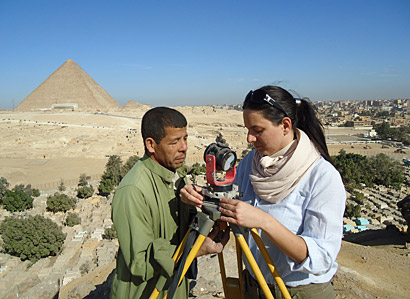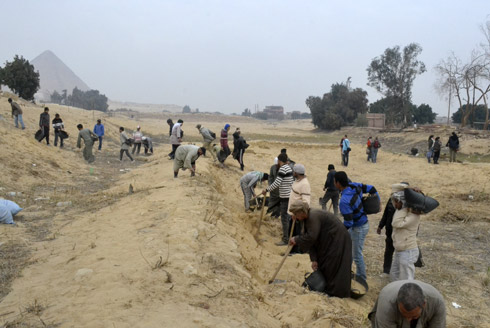A Season of Migration to the South
By Ana Tavares (joint Field-Director)
Gradually the team assembles at Giza for the 2015 excavation season. For most of us, this involves travelling south – away from cold weather, storms and snow. It is wonderful to be back in the warmth of the Giza plateau.
We have been preparing for the season for weeks; assembling equipment, organizing documentation, surveying the excavation grid, cleaning the site from vegetation, and removing the protective layer of sand (backfill) which protects the mud brick ruins in between excavation seasons. We also prepared manuals, lectures and equipment for the field-school students. Field-schools are an important component of AERA’s fieldwork and this year we celebrate the 10th anniversary of the AERA/ARCE field-school. We would like to assemble alumnae from all over Egypt and celebrate with a party towards the end of the season!

Surveying the excavation grid. Virag sets up the reflector helped by Shaltout. Photo by Kirk Roberts.
Beer and Meat
The site work also takes us south. This season we are back in the Heit el-Ghurab settlement, investigating two areas in the southern part of the site. These areas are named AA-south and SWI (for Standing Wall Island). The research questions for the season centre on ‘beer and meat’.
The southern part of the site is occupied by a neighbourhood which we named the ‘Western Town’. Here we identified very large houses for scribes and administrators of the settlement. In the spaces between the villas a series of storage and food production structures were built. One such structure was the Pedestal Building in the area named AA. This was the very first area to be excavated by the project, way back in 1989!
We return to the area just south of this building to investigate a maze of walls and burnt circles (possibly ovens or kilns). We know that beer was a staple food of the inhabitants of Heit el-Ghurab but we have not been able to identify beer production facilities on site. Beer making is shown on Old Kingdom tomb reliefs and ‘breweries’ dated to the pre-dynastic period have been excavated in Egypt. We investigate AA-south to test the hypothesis that this area may have structures for beer production. As we have already excavated the Pedestal Building to the north, House Unit 1 and Pottery Mound to the east, this season’s work will also give us a glimpse of the development of a neighbourhood.

The workers remove the protective layer of sand from the western side of the SWI enclosure. View to the north, photo by Saied Salah.
Further south we investigate a large stone enclosure. The walls we recorded here were standing high, above low lying areas to the north and southeast, earning the name – Standing Wall Island (SWI). We hypothesized that this may have been a cattle enclosure. This season we test this hypothesis by investigating selected areas of the wall and the mudbrick structures in the northern half of the enclosure.
We also planned, for this season, survey work , research in the Giza Laboratory and recording in the Menkaure Valley Temple. We will keep you posted….
